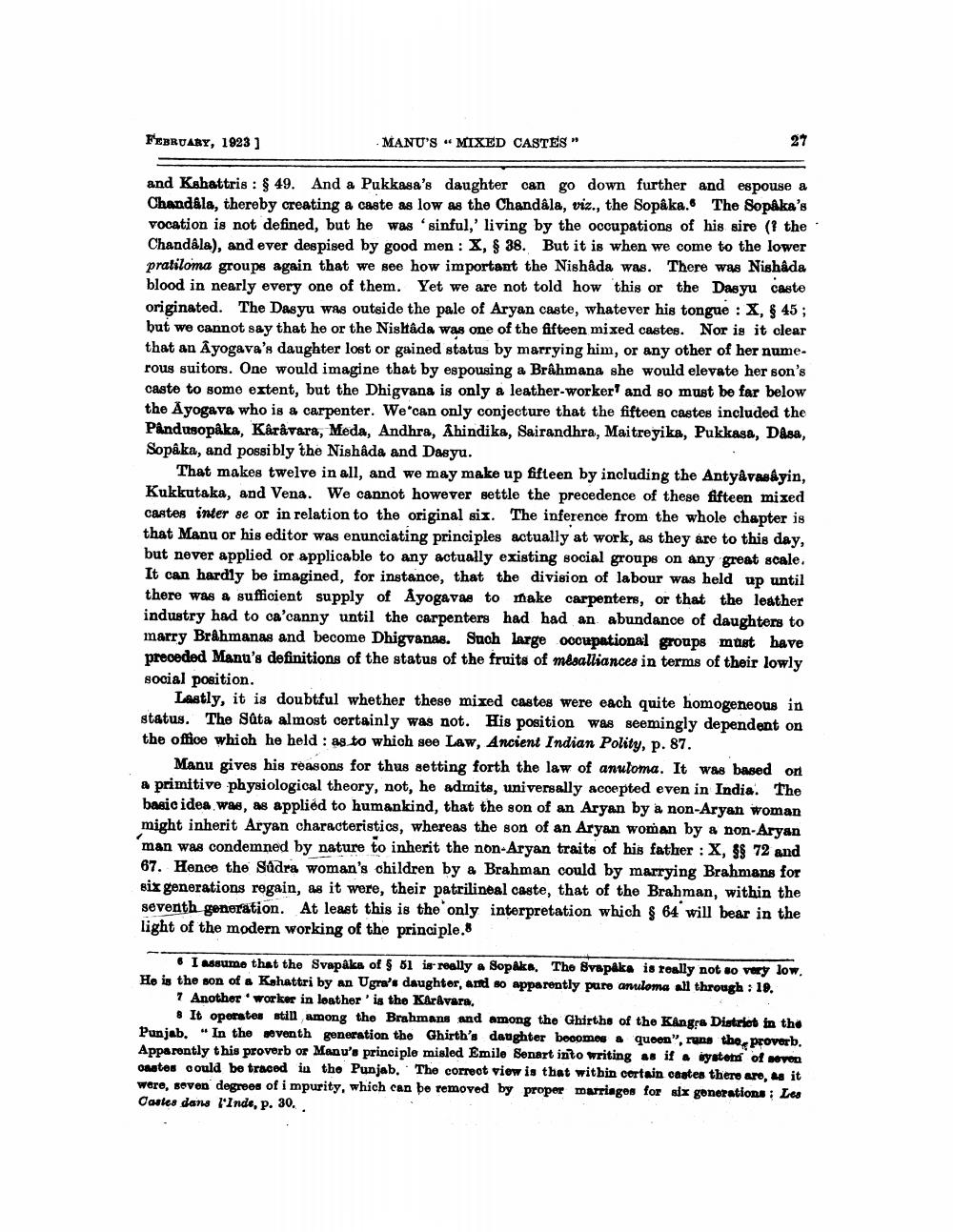________________
FEBRUARY, 1923]
MANU'S MIXED CASTES "
27
and Kahattris: § 49. And a Pukkasa's daughter can go down further and espouse a Chandala, thereby creating a caste as low as the Chandâla, viz., the Sopâka. The Sopâka's vocation is not defined, but he was 'sinful,' living by the occupations of his sire (? the Chandâla), and ever despised by good men : X, § 38. But it is when we come to the lower pratiloma groups again that we see how important the Nishâda was. There was Nishâda blood in nearly every one of them. Yet we are not told how this or the Dasyu caste originated. The Dasyu was outside the pale of Aryan caste, whatever his tongue : X, § 45; but we cannot say that he or the Niskâda was one of the fifteen mixed castes. Nor is it clear that an Ayogava's daughter lost or gained status by marrying him, or any other of her nume. rous suitors. One would imagine that by espousing a Brahmana she would elevate her son's caste to some extent, but the Dhigvana is only a leather-worker' and so must be far below the Ayogava who is a carpenter. We can only conjecture that the fifteen castes included the Pândusopaka, Kârâvara, Meda, Andhra, Ahindika, Sairandhra, Maitreyika, Pukkasa, Dasa, Sopaka, and possibly the Nishâda and Dasyu.
That makes twelve in all, and we may make up fifteen by including the Antyavasayin, Kukkutaka, and Vena. We cannot however settle the precedence of these fifteen mixed castes inter se or in relation to the original six. The inference from the whole chapter is that Manu or his editor was enunciating principles actually at work, as they are to this day, but never applied or applicable to any actually existing social groups on any great scale. It can hardly be imagined, for instance, that the division of labour was held up until there was a sufficient supply of Ayogavas to make carpenters, or that the leather industry had to ca'canny until the carpenters had had an abundance of daughters to marry Brahmanas and become Dhigvanas. Such large occupational groups must have preceded Manu's definitions of the status of the fruits of mesalliances in terms of their lowly social position.
Lastly, it is doubtful whether these mixed castes were each quite homogeneous in status. The Sûta almost certainly was not. His position was seemingly dependent on the office which he held as to which see Law, Ancient Indian Polity, p. 87.
Manu gives his reasons for thus setting forth the law of anuloma. It was based on a primitive physiological theory, not, he admits, universally accepted even in India. The basic idea was, as applied to humankind, that the son of an Aryan by a non-Aryan woman might inherit Aryan characteristics, whereas the son of an Aryan woman by a non-Aryan man was condemned by nature to inherit the non-Aryan traits of his father: X, §§ 72 and 67. Hence the Sûdra woman's children by a Brahman could by marrying Brahmans for six generations regain, as it were, their patrilineal caste, that of the Brahman, within the seventh generation. At least this is the only interpretation which § 64 will bear in the light of the modern working of the principle.8
I assume that the Svapaka of § 51 is really a Sopaka, The Svapaka is really not so very low. He is the son of a Kehattri by an Ugra's daughter, and so apparently pure anuloma all through: 19. 7 Another worker in leather' is the Kârâvara,
s It operates still among the Brahmans and among the Ghirths of the Kangra District in the Punjab. "In the seventh generation the Ghirth's daughter becomes a queen", runs the proverb. Apparently this proverb or Manu's principle misled Emile Senart into writing as if a system of seven castes could be traced in the Punjab. The correct view is that within certain castes there are, as it were, seven degrees of impurity, which can be removed by proper marriages for six generations; Les Castes dans l'Inde, p. 30.




